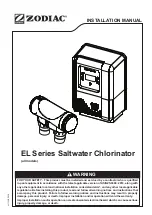
BEAR | 2017 |
page 15
9. Water distiller without built in tank installa-
tion
9.1.
IMPORTANT:
In order to avoid manual adjustment of the water flow through
the tap, the flow rate limitation nozzle 9, which throttles the flow of water in the
range of 0.15-0.5 MPa (the optimum pressure is 0.15-0.2 MPa) is installed in
this water distiller. This provides the minimum flow and maximum performance
of the water distiller.
9.2. The throttle orifice in the nozzle has a small cross-section and can be clogged with par-
ticles of sand or salt-containing sediments. Therefore, to avoid clogging of the nozzle,
as well as for monitoring pressure in system of water supply, it is recommended to install
in the water supply system a pressure regulator with a pressure gauge and a self-clean-
ing filter (with 100-micron filtration fineness).
9.3. In case of clogging the nozzle, the water distiller begins to emit steam, the productivity
decreases. In the absence of flow of water through the nozzle, the water level in the
evaporator becomes insufficient, overheating of the heater will occur leading to trigger-
ing of the thermal overload switch 13 and the full disabling of the water distiller.
9.4. In the case of frequent nozzle clogging, if the filter is not installed, the nozzle may be
removed from the water distiller. The consumption of water should be controlled with a
valve supplied. The flow rate is considered optimal, when the temperature at the outlet
of the heat exchanger (water temperature Equalizer) is about 70-80 degrees Celsius.
9.5. Install water distiller on the table, using the level gauge and avoiding slants.
9.6. Attach the silicone tube (L = 0.5 m) to the distillate drain pipe 5.
9.7. Connect the drain hose to the cooling water drain pipe 12.
9.8. Tighten the connection of the hose and the cooling water drain pipe 12 with the screw
clamp supplied.
9.9.
IMPORTANT:
The drain from the drain hole should be free: the cooling water
drain hose should be at a slant, and it should not have any twists and kinks (if
necessary, reduce the length of the hose). The height difference between the
drain hole and location of connection of the hose to the sewage system should
be at least 0.3 m. Otherwise, an air lock may appear, the water level in the
evaporator will begin to rise and overflow of water from the equalizer will start.
9.10. Connect the 1/2” ball valve (supplied) through the sealing strip to the pipe 7 (Figure 5).
9.11. Connect one end of the 1/2” flexible water piping to the ball valve and the other end to
the water supply system through the ½ “brass filter (supplied).
9.12. Attach the fitting with 1/2’‘male thread through the sealing tape to the valve for waste
water drain from the evaporator.
9.13. Connect the hose for waste water drain from the evaporator to the fitting of the water
still.
9.14. Tighten the connections of hoses and fittings with the clamps supplied.
9.15. Connection to mains:
9.16. The circuit breaker is not supplied, is purchased by the consumer and selected based
on the calculation of the In+10% overcurrent tripping setting (where In is a rated current)
9.17. Connect the water still grounding terminal to the PE bus with flexible copper wire at








































